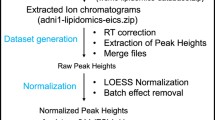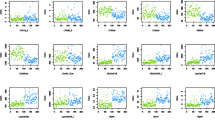Abstract
Lipidomic analysis is able to measure simultaneously thousands of compounds belonging to a few lipid classes. In each lipid class, compounds differ only by the acyl radical, ranging between C10:0 (capric acid) and C24:0 (lignoceric acid). Although some metabolites have a peculiar pathological role, more often compounds belonging to a single lipid class exert the same biological effect. Here, we present a lipidomics workflow that extracts the tandem mass spectrometry data from individual files and uses them to group compounds into structurally homogeneous clusters by chemical structure hierarchical clustering analysis (CHCA). The case-to-control peak area ratios of the metabolites are then analyzed within clusters. We created two freely available applications to assist the workflow: FragClust to generate the tables to be subjected to CHCA, and TestClust to perform statistical analysis on clustered data. We used the lipidomics data from the plasma of Alzheimer's disease (AD) patients in comparison with healthy controls to test the workflow. To date, the search for plasma biomarkers in AD has not provided reliable results. This article shows that the workflow is helpful to understand the behavior of whole lipid classes in plasma of AD patients.

Chemical Hierarchical Cluster Analysis applied to Lipidomics. Software assisted workflow.




Similar content being viewed by others
References
Li M, Yang L, Bai Y, Liu H. Analytical methods in lipidomics and their applications. Anal Chem. 2014;86:61–75.
Hu C, van der Heijden R, Wang M, van der Greef J, Hankemeier T, Xu G. Analytical strategies in lipidomics and applications in disease biomarker discovery. J Chromatogr B. 2009;877:2836–46.
Meikle PJ, Christopher MJ. Lipidomics is providing new insight into the metabolic syndrome and its sequelae. Curr Opin Lipidol. 2011;22:210–5.
Rolim AE, Henrique-Araújo R, Ferraz EG, de AraújoAlvesDultra FK, Fernandez LG. Lipidomics in the study of lipid metabolism: current perspectives in the omic sciences. Gene. 2015;554(2):131–9.
González-Domínguez R, García-Barrera T, Gómez-Ariza JL. Metabolomic study of lipids in serum for biomarker discovery in Alzheimer's disease using direct infusion mass spectrometry. J Pharm Biomed Anal. 2014;98:321–6.
Mapstone M, Cheema AK, Fiandaca MS, Zhong X, Mhyre TR, MacArthur LH, et al. Plasma phospholipids identify antecedent memory impairment in older adults. Nat Med. 2014;20(4):415–8.
Watson AD. Thematic review series: systems biology approaches to metabolic and cardiovascular disorders. Lipidomics: a global approach to lipid analysis in biological systems. J Lipid Res. 2006;47(10):2101–11.
Summers SA. Ceramides in insulin resistance and lipotoxicity. Prog Lipid Res. 2006;45(1):42–72.
Mathias S, Peña LA, Kolesnick RN. Signal transduction of stress via ceramide. Biochem J. 1998;335(3):465–80.
Myers DS, Ivanova PT, Milne SB, Brown HA. Quantitative analysis of glycerophospholipids by LC-MS: acquisition, data handling, and interpretation. Biochim Biophys Acta. 2011;1811(11):748–57.
Backman TW, Cao Y, Girke T. ChemMine tools: an online service for analyzing and clustering small molecules. Nucleic Acids Res. 2011;39 Suppl 2:W486–91.
Camarda R, Monastero R. Prevalence of primary headaches in Italian elderly: preliminary data from the Zabút Aging Project. Neurol Sci Suppl. 2003;2:S122–4.
American Psychiatric Association. Diagnostic and statistical manual of mental disorders. 4th ed. Washington: American Psychiatric Association; 1994.
McKhann G, Drachman D, Folstein M, Katzman R, Price D, Stadlan EM. Clinical diagnosis of Alzheimer's disease: report of the NINCDSADRDA Work Group under the auspices of Department of Health and Human Services Task Force on Alzheimer's Disease. Neurology. 1984;34(7):939–44.
Monastero R, Cefalù AB, Camarda C, Noto D, Camarda LK, Caldarella R, et al. Association of estrogen receptor alpha gene with Alzheimer's disease: a case–control study. J Alzheimers Dis. 2006;9(3):273–8.
Bird SS, Marur VR, Sniatynski MJ, Greenberg HK, Kristal BS. Serum lipidomics profiling using LC-MS and high-energy collisional dissociation fragmentation: focus on triglyceride detection and characterization. Anal Chem. 2011;83(17):6648–57.
Zhang Y, Wen Z, Washburn MP, Florens L. Effect of dynamic exclusion duration on spectral count based quantitative proteomics. Anal Chem. 2009;81(15):6317–26.
Hodge K, Have ST, Hutton L, Lamond AI. Cleaning up the masses: exclusion lists to reduce contamination with HPLC-MS/MS. J Proteomics. 2013;88:92–103.
Smith CA, Want EJ, O'Maille G, Abagyan R, Siuzdak G. XCMS: processing mass spectrometry data for metabolite profiling using nonlinear peak alignment, matching and identification. Anal Chem. 2006;78:779–87.
Kuhl C, Tautenhahn R, Böttcher C, Larson TR, Neumann S. CAMERA: an integrated strategy for compound spectra extraction and annotation of liquid chromatography/mass spectrometry data sets. Anal Chem. 2012;84(1):283–9.
Smith CA, O'Maille G, Want EJ, Qin C, Trauger SA, Brandon TR, et al. METLIN: a metabolite mass spectral database. Ther Drug Monit. 2005;27(6):747–51.
Fahy E, Subramaniam S, Brown HA, Glass CK, Merrill Jr AH, Murphy RC, et al. A comprehensive classification system for lipids. J Lipid Res. 2005;46(5):839–61.
de Hoon MJ, Imoto S, Nolan J, Miyano S. Open source clustering software. Bioinformatics. 2004;20(9):1453–4.
Saldanha AJ. Java Treeview—extensible visualization of microarray data. Bioinformatics. 2004;20(17):3246–8.
Chen Y, Liu Y, Sullards MC, Merrill Jr AH. An introduction to sphingolipid metabolism and analysis by new technologies. Neuromol Med. 2010;2(4):306–19.
Butovich IA. On the lipid composition of human meibum and tears: comparative analysis of nonpolar lipids. Investig Ophthalmol Vis Sci. 2008;49(9):3779–89.
Tong H, Bell D, Tabei K, Siegel MM. Automated data massaging, interpretation, and E-mailing modules for high throughput open access mass spectrometry. J Am Soc Mass Spectrom. 1999;10:1174–8.
Busik JV, Reid GE, Lydic TA. Global analysis of retina lipids by complementary precursor ion and neutral loss mode tandem mass spectrometry. Methods Mol Biol. 2009;579:33–70.
Kemppinen A, Kalo P. Quantification of triacylglycerols in butterfat by gas chromatography-electron impact mass spectrometry using molar correction factors for [M-RCOO] + ions. J Chromatogr A. 2006;1134(1–2):260–83.
Sun GY, Xu J, Jensen MD, Simonyi A. Phospholipase A2 in the central nervous system: implications for neurodegenerative diseases. J Lipid Res. 2004;45(2):205–13.
Acknowledgments
The authors thank Leopoldo Ceraulo from the University of Palermo for his precious contribution in the writing and proofreading of the manuscript.
Author information
Authors and Affiliations
Corresponding author
Ethics declarations
The study was approved by the local ethics committee and written informed consent was obtained from all participants or their legal representatives. The procedures adopted were in accordance with the Helsinki Declaration of 1975, as revised in 1983, and were approved by the Ethics Committee of the University of Palermo.
Conflict of interest
The authors declare that they have no conflict of interest.
Additional information
Francesca Di Gaudio, Sergio Indelicato contributed equally to this work.
Davide Noto and Maurizio R. Averna contributed equally to this work.
Electronic supplementary material
Below is the link to the electronic supplementary material.
ESM 1
(PDF 1079 kb)
Rights and permissions
About this article
Cite this article
Di Gaudio, F., Indelicato, S., Monastero, R. et al. FragClust and TestClust, two informatics tools for chemical structure hierarchical clustering analysis applied to lipidomics. The example of Alzheimer's disease. Anal Bioanal Chem 408, 2215–2226 (2016). https://doi.org/10.1007/s00216-015-9229-6
Received:
Revised:
Accepted:
Published:
Issue Date:
DOI: https://doi.org/10.1007/s00216-015-9229-6




